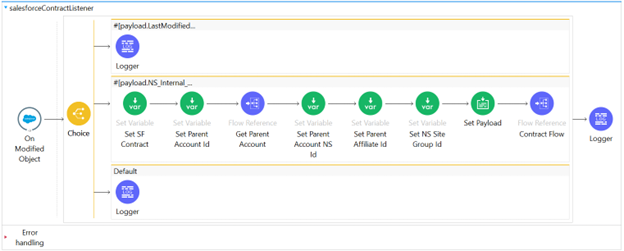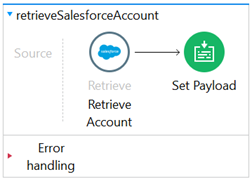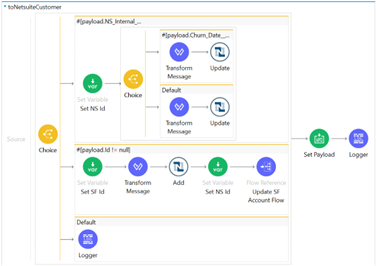Seamless Data Flow: A MuleSoft Data Integration Showcase

In any business environment, the ability to seamlessly integrate applications and databases is paramount. It not only enhances efficiency but also ensures the integrity of data across platforms. In this case study, we delve into two critical integration scenarios: synchronizing Salesforce with NetSuite in a one-way data flow and replicating data from NetSuite into a SQL Server database.
MuleSoft: Empowering Your Data Integration Solution
Before diving into the specifics of our case study, let’s explore what MuleSoft is and how it serves as a powerful tool for data integration.
What is MuleSoft?
MuleSoft is an integration platform that enables organizations to connect disparate systems, applications, and data sources. It acts as a bridge between various software applications, databases, and cloud services, facilitating seamless communication and data flow. MuleSoft’s Anypoint Platform offers a comprehensive set of tools and services for designing, building, and managing integrations, making it an ideal choice for tackling complex data integration challenges.
How MuleSoft Facilitates Data Integration
MuleSoft simplifies data integration through a combination of key features and capabilities:
- Connectivity: MuleSoft provides a wide range of connectors and APIs that allow you to connect to diverse systems and data sources, including cloud-based applications, on-premises databases, and legacy systems.
- Orchestration: With MuleSoft, you can design integration workflows, known as Mule flows, that define how data is routed, transformed, and processed between systems. This orchestration ensures that data moves smoothly from source to destination.
- Transformation: MuleSoft offers powerful data transformation capabilities, allowing you to convert data formats, enrich information, and ensure compatibility between systems.
- Monitoring and Management: MuleSoft provides tools for monitoring the health and performance of integrations in real-time. It also offers management features for version control, security, and governance.
Data Integration Patterns
Next, let’s understand the data integration patterns at play. These patterns serve as our blueprint for creating robust connections between Salesforce and other platforms:
- Migration: This pattern involves moving data from one system to another, often during system upgrades or migrations.
- Broadcast: The broadcast pattern disseminates data from a single source to one or multiple recipients, ensuring real-time information distribution.
- Aggregation: Aggregation integrates data from multiple sources into a unified view, providing a comprehensive understanding of information spread across various systems.
- Bidirectional Synchronization: This pattern enables data to flow in both directions, allowing systems to share and update information bidirectionally.
- Correlation: Correlation patterns match data from multiple sources based on defined criteria, facilitating the creation of meaningful relationships between disparate data sets.
These patterns guide our efforts to establish seamless connections between applications, ensuring data consistency and reliability throughout the integration process. In this case, we’ll focus on a broadcast integration pattern, from Salesforce to NetSuite.
Salesforce to NetSuite
Our journey begins with the intricate task of synchronizing Salesforce and NetSuite. We identified four key objects to sync, each forming part of a hierarchical structure. When one object is updated in Salesforce, we aim to sync all related objects in NetSuite. Additionally, when records are created in NetSuite, we want to write the corresponding NetSuite ID back to the Salesforce records for future reference.
The integration design relies on MuleSoft’s Salesforce Connector, allowing us to set up listeners for Salesforce objects efficiently. To toggle between production and development environments, we utilize workflow parameters, streamlining configuration during testing and deployment. A crucial optimization step involves setting variables based on the payload object, facilitating shared sub flows for all record types.
Our integration efforts encompass Salesforce objects like accounts, opportunity services, and contracts. To execute seamless data transfer, we employ MuleSoft’s NetSuite connector, ensuring data consistency and reliability. The configuration of environment credentials for both Salesforce and NetSuite guarantees secure and authenticated access.
Thorough testing, including unit and user acceptance tests, was essential to validate the integration’s functionality. The final stage involved exporting the application to the organization’s MuleSoft Anypoint Exchange, from where it was deployed to MuleSoft’s CloudHub server.
The outcome was transformative. Data is now automatically kept in sync between NetSuite and Salesforce, eradicating the need for manual data entry. The integration not only improves efficiency but also eliminates the potential for user errors associated with manual data input.
NetSuite to SQL Server Database
Moving forward, we shift our focus to the task of extracting data from NetSuite and replicating it in SQL Server database tables. This process, scheduled to run nightly, ensures that insights are readily available to decision-makers.
The integration design begins with a MuleSoft scheduler element, enabling us to execute the application at specified intervals or on a set time schedule. Subsequently, we employ the MuleSoft NetSuite connector to perform data searches, retrieving the necessary information from the NetSuite instance. The results are stored in the application payload, with field mappings ensuring compatibility with the target database columns.
Before inserting data, we truncate the target database table, ensuring that we start with a clean slate. The data insertion itself is accomplished using the MuleSoft database connector’s bulk insert functionality, which streamlines the process and enhances performance.
The testing and deployment phase was relatively smooth, with most objects integrating seamlessly. However, for a few objects with substantial data volumes, resource constraints necessitated adjustments. To address this, we updated the MuleSoft application to perform bulk inserts within a for-each loop, reducing data size per insertion and optimizing resource utilization.
The ultimate outcome was highly rewarding. Data from NetSuite is now efficiently exported to the SQL Server database, where Azure Data Factory runs stored procedures to facilitate seamless data loading into Power BI. This transformation has empowered the organization with valuable insights from NetSuite data, which drive strategic decisions and actions.
In conclusion, this case study showcases the power of MuleSoft data integration in bridging the gap between Salesforce and NetSuite, eliminating manual data entry, and ensuring data accuracy. Additionally, the replication of NetSuite data into a SQL Server database has enabled the organization to harness data-driven insights for making strategic decisions. These integrations have not only enhanced operational efficiency but have also positioned the organization for data-driven success in a competitive landscape.
Intrigued by the transformative potential of MuleSoft integration for your organization? Connect with us at info@kenwayconsulting.com for further insights and discussions on how these solutions can be tailored to your unique needs.












